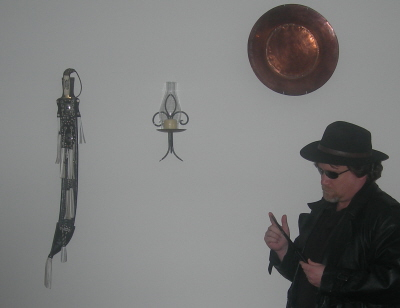|
About This Author
Come closer.
|
Complex Numbers
Complex Numbers
A complex number is expressed in the standard form a + bi, where a and b are real numbers and i is defined by i^2 = -1 (that is, i is the square root of -1). For example, 3 + 2i is a complex number.
The bi term is often referred to as an imaginary number (though this may be misleading, as it is no more "imaginary" than the symbolic abstractions we know as the "real" numbers). Thus, every complex number has a real part, a, and an imaginary part, bi.
Complex numbers are often represented on a graph known as the "complex plane," where the horizontal axis represents the infinity of real numbers, and the vertical axis represents the infinity of imaginary numbers. Thus, each complex number has a unique representation on the complex plane: some closer to real; others, more imaginary. If a = b, the number is equal parts real and imaginary.
Very simple transformations applied to numbers in the complex plane can lead to fractal structures of enormous intricacy and astonishing beauty.
April 15, 2020 at 12:21am April 15, 2020 at 12:21am
| |
Sometimes, I share a link because it gives me an excellent opportunity for a pun in the blog entry title.
This is one of those times.
Also, the subject is fascinating.
https://www.quantamagazine.org/to-make-the-perfect-mirror-physicists-confront-th...
To Make the Perfect Mirror, Physicists Confront the Mystery of Glass
Sometimes a mirror that reflects 99.9999% of light isn’t good enough.
The Laser Interferometer Gravitational-Wave Observatory can sense movements thousands of times tinier than the width of an atom partly because of the instrument’s near-perfect mirrors. The mirrors bounce laser beams back and forth down the arms of LIGO’s L-shaped detectors. Changes in the relative lengths of the arms reveal when a gravitational wave flutters past Earth, stretching and squeezing space-time.
LIGO, by itself, is incredibly cool. Well, not as cool as a liquid helium superconductor (that's another pun), but it's one of those triumphs of physics and engineering that's clever as hell and allows us to probe the depths of the universe. With it, scientists have detected the gravitational waves produced from black hole mergers halfway across the visible universe -- and thus verified another of Einstein's predictions.
But this article isn't about gravitational waves or astronomy. It's about something much more familiar, something most of us see every day and so don't think about much.
LIGO’s mirrors are imperfect, however, because of a strange form of noise that is baked into glass, a mysterious substance in general. Glass consists of atoms or molecules that are haphazardly arranged like those in a liquid yet somehow stuck, unable to flow.
I just wanted to throw out an aside here. I remember being told as a kid that glass is a "solid liquid" and that, over long periods of time, it flows very slowly, and that's why glass windows in older buildings exhibit wavy distortions.
I keep hearing references to this, but it is utter and complete nonsense.
The reason windows in older buildings give a distorted view of the world is that the technology to make the glass wasn't as refined as it is today, and so there are small variances in thickness across the pane. This leads to inconsistent refraction of whatever light passes through it, giving the scene that slightly distorted appearance. To be perfectly clear (pun intended), glass is as solid as it gets; it wouldn't exhibit any noticeable flow in the couple of hundred years since clear glass became a thing for windows.
The reason for this confusion is that glass is, in a sense, a solid liquid. "But Waltz, you just said that was nonsense." What I mean by a solid liquid is that in silica glass, the arrangement of atoms is chaotic, not regular as in a crystal or a metal. In that sense, it's kind of like a liquid, with atoms in an irregular configuration. That's not why it's clear, of course; many plastics are also amorphous, even the opaque ones, and quartz (also silica), a crystal with a regular atomic structure, is transparent as well.
But anyway, back to the article.
Hellman’s group is looking for something approaching “ideal glass,” a hypothetical phase of matter predicted decades ago. The molecules in ideal glass are theoretically packed together in the densest possible random arrangement...
And whenever I try to imagine a "densest possible random arrangement," my mind blanks. This is why I'm not an actual physicist or materials scientist.
The rest of the article gets a bit technical ("Oh, like it wasn't already"), but again, this stuff is fascinating.
And pun-worthy. |
© Copyright 2025 Robert Waltz (UN: cathartes02 at Writing.Com). All rights reserved.
Robert Waltz has granted InkSpot.Com, its affiliates and its syndicates non-exclusive rights to display this work.
|

